Murals in Singapore
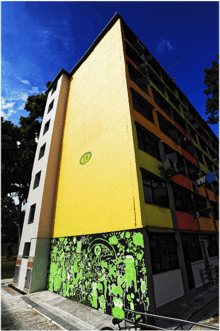
Singapore Murals is an integral part of the nation's aspiration of being a renaissance city but is under developed. A Public Mural is a source of heritage building, expression of the arts, national education, interactivity of interests groups.
Publications
There are many publications found globally that showcase street art (both graffiti and commission works). However, there are not sufficient resources in Singapore. For example, in Page One bookstores dozens of books about Vandalism on Trains can be found.
Location
In Singapore, public murals exist primarily in three aspects:
Commercially commissioned works
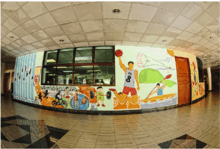
This mainly take the form of corporate malls but more prominently by the Land Transport Authority in its building of Mass Rapid Trains. The theory of "the less the artist is paid, the more autonomy he has" is very relevant to understand of murals.
Void-decks and facade of centres
The Singapore residential area is mainly high rise HDB Flats. The first floor of HDB Flats[1] is commonly used by Educational Centres, venue of Residential Committees/Community Clubs. These centres do carry some murals.
The inbetweens or the "illegals"
Street Art does exist in between sewage drains, the back of alleys and landed properties and even power boxes.
History
The oldest mural in Singapore can be traced to Changi Murals, which still are in existence. There were previous recorded murals in Orchard Road and some parks. However, they do not exist currently.
Orchard Road
In 1985, Organised by Wisma Development Pte Ltd and Forum Development Pte Ltd attracted Nanyang Academy of Fine Arts and St Patricks's Arts Centre to create 7 murals along Orchard Road. The hoardings at Atria was divided into 14 panels per team, each panel were 4.5m to 2.2m. The painting themes were evolution of shopping in Singapore and evolution of lifestyle.[2]
Chijmes
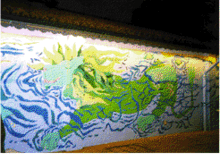
The next prominent mural in Singapore arrives at the facade of Chijmes in 1987. Le Mur Lion; The Lion Wall, portrays and tells through imagery the rousing myth about a lion and its struggling journey towards finding a better world. Stretched across the walls on Brash Basah Road estimated to be about 125 meters, it was apparently assumed to be the longest wall mural in Singapore.
Bras Basah Murals
In 2004, the Urban Redevelopment Authority introduced the Bras Basah Murals. Named after the 1815 Battle of Waterloo, Waterloo street is now known for its rich housing towards the arts.
To further enhance this area as a hub for Arts, Culture, Learning and Entertainment three wall murals have since been produced and unveiled along Waterloo Street. These murals were a collaborative effort from the students of NAFA and Lasalle-SIA and URA (Urban Redevelopment Authority).
Located at the boundary wall of Stamford arts centre, the first two wall murals located at the wall of Stamford Arts Centre, were painted by URA and Lasalle-sia students. The art direction for these two murals was to bring out the unique blend of architecture in the area. A significant amount of different colours was used to represent architecture and rich cultural heritage that is prominent with the many religious buildings in the Bras Basah area.
The third mural, which was produced by NAFA, is meant to depict the challenges women face in our society. The site-specific mural, which stands next to the SCWO Centre further instills the message.
2010 Bras Basah Complex Mural
The project was facilitated through the assistance of the National Volunteerism and Philanthropy Centre that engaged the American Chambers of Commerce Day. Over 100 volunteer hours were team up together to create a colour masterpiece led by budding artist Koochi who was mentored by Asst Professor Eileen Reynolds from Nanyang Technological University. Completed on 13 November 2010, the artworks represent different colours coming together and movement forward for the Arts. The artwork was themed to "arrangement" which is similar to books and arts. Bras Basah Complex is known for its niche of Books and Arts materials.
Mural.sg Launch
The beta version (Wikipedia) page of Murals.sg was launched on 19 October 2010 by Member of Parliament Ms Penny Low. The Punggol North GROs kindly hosted a tea reception for over 100 participants of the mural painting and will not be possible through the kind assistance of the Social Innovation Park and PCF.
Through the assistance of the National Volunteerism and Philanthropy Centre, over 15 collaborations were made to further strengthen murals painting in Singapore. Their assistance include the introduction of corporate volunteers and funds.
People involved
- Mentor Artist: Professional artists, lecturers and practicing artists who have organised exhibitions both solo and group
before. They concentrate of specific themes and styles. Their take away are acts are sharing of talents, education to youths and volunteerism.
- Budding Artists: Students of Art or working adults who does art as a hobby. They received avenues of expression, opportunities of interactions, character development.
- Interest Groups (non-artists): People with similar attributes or affiliated with a registered charity i.e. youths at risks, elderly etc. This include corporate volunteers as well and/or social service groups. Art therapy, team bonding and community message.
Internationalisation
In the United Kingdom, the Off The Wall organisation brought Invergorden Mural Trail that was officiated by Her Princess Royal and the total transformation costs over GBP 220,000. It was commissioned by the European Union.
Programmes such as City of Philadelphia Mural Arts Programme, City Without Walls in New Jersey, Community Murals in UK and many others work towards addressing key issues and concerns in the society such as affordable housing, health, education and other issues, and at the same time bringing communities together.
Mural Organisations
There were quite a number of organisations and public bodies coming up with murals. However, most of them are ad hoc efforts. For example, the URA Bras Basah Murals are currently peeling off at this very second.
*scape
- scape started as a department of youth ventures in the National Youth Council (government) but later become a company limited by guarantee. It manages the Skate Park, Youth Park and *scape centre. With an emphasis of a youth space, many activities are organised. A whole building mural at *scape centre was launched. There used to be an area at youth park where any artist can paint on the walls. However, since 2008, prior approval was needed. *scape activities seemed to be within their spaces. In August 2014, *scape engaged Built from Skratch, Project Burnerz (Asno Doink, S13 & Myow) and KiddVybe & his Brother Syafiq to recreate a new mural
Challenges of Singapore Murals
Singapore Murals faced several main challenges.
- Overlap of government involvement without a clear direction on whose mandate are public murals. Is Community Art more Community or Artistic, and both have different ministries looking into its development.
- Strict vandalism laws which were highlighted by a recent vandalism on MRT Train by a Swiss National.
- No free walls. *scape allows artists in particular graffiti artists to spray cans on their walls. However, from 2008 prior approval of artwork was needed.
- Artistic delivery. As most venues belong are in community space, public murals are at the risk of being too inline with government campaigns in their artworks. On 08.07.2010, The Straits Times reported that an anti-drug mural was completed.
- Dilution of artistic merits because of government being too involved. In 2012, the government issued a 210million dollars for arts-culture community engagement. However, the amount went mainly to People's Association that hires an untrained arts officer at each community club (approx 84).[3]
Artwork
Singapore Murals goes beyond painting. Murals in MRT Trains do contain built in wall sculptures as well as cemented drawings. Murals which are painting based seemed to relate greater to graffiti than fine arts. Here are some of the murals found in Singapore
Mural about Baharudin Vocational Institute

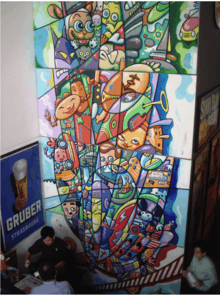
Being one of the first ever art devoted school; Baharuddin Vocational Institute grew from humble grounds. From various name changes over the years and starting without a building of their own, they had to resort to borrowing premises to house their students.
In 1970, they moved into their own building where they housed students undertaking courses from graphic design to doll making. Baharuddin Vocational Institute was more than just a school. I say this because as surprising as it may seem now, it was the first and only school to provide art courses in the 1970s. Thus being the only faculty that taught students everything artistically involved, Baharuddin Vocational Institute gave birth to our very first locally taught creative individuals. These individuals such as Zoe Tay and Makansutra’s KF Seetoh were great additions to Singapore’s creative industry.
Mint Museum
Opened on 5 March 2007, Mint (Moment of Imagination and Nostalgia with Toys) Museum was illuminated with is signature mural designed and painted by Norwegian artist, Einstein Kristiansen.
The main artistic direction as quoted by Mr. Kristiansen "The first piece of art a child does, when introduced to a pencil"
With vast use of colours, texture through shading and meticulous details, this mural was entitled "Krusedulle". Krusedulle, the Norwegian word for doodles is meant to depict the museum and the collectables of the toys it carries.
This mural is dissected into five panels.
Tribute to Street-Side Hawker
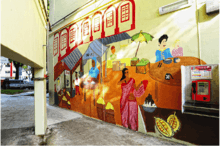
Located at Blk 123, Stirling Road, this mural was created in dedicatory and recognition to all street side hawkers.
Colours of Diversity

In Social Creatives series of 20 murals around Queenstown, Colours of Diversity was the last installation to mark the end of this massive transformation project around the area. During this process, social creative managed to capture the support of Keppel Corp.; a leading organization. This led to the collaboration and community engaging experience. Keppel Volunteers decided to lend a hand while social creatives lent them the paint and brushes.
Water Polo
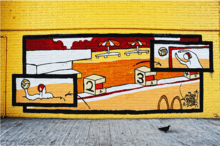
On 11 December 2009, this mural was completed opposite the Queens Town Swimming Complex. The artist was Mr. Raziz a.k.a. Mr. Bombster. With him, a group of migrant workers actually volunteered in the production of this piece of work.
Splat
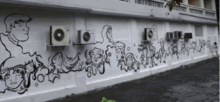
This mural was created by young artists Cheryl, Beryl and Ching. Entitled Faces of Singapore, this black and white design features the facial expressions of all citizens.[4]
Story of Radin Mas
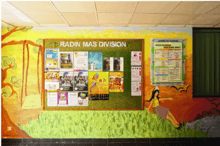
This mural above depicts the life behind Radin Mas. It was led by German artist Jan Kolster and Singaporean Gladys Teo. The project engaged 200 elderly people and was launched by Mr Sam Tan, Parliamentary Secretary of the Ministry of Information, Communication and the Arts on 20 December 2010.
Radin Mas was a young and beautiful princess who unfortunately came across an ill-fated life. She was killed accidentally while someone else was trying to kill her father. Before death, her life was not much easier. She was forced to wed the evil Tengku Bagus while her father was held in captivity in a well.
Punggol Murals
Punggol was given a face lift with a serious dose of colour and vibrancy on from organised programmes in July to October 2010. A series of 15 walls were transformed with the help of about 500 participants from Standard Chartered Bank, Temasek Poly, NTUC Fairprice, Mercer, Daimler SEA and so on. With such massive collaboration, the participants walked away feeling proud that each and every one of them became an artist that day.
Murals currently exist in two sub towns of Punggol which are Edgedale Plains and EdgeField.
Street (Void-Deck) Art Gallery
In 2011, Social Creatives launched an initiative that transform the first floor and common space of a residential area into an art gallery which are inspired by the artworks of Vincent van Gogh. Another gallery was launched in 2012 but through the impressions of pop art masterpieces. This signature initiative of Social Creatives has appeared on local TV shows and even on CNN. According to an article by CNN: In straight-laced Singapore, where graffiti tag artists can get sent to prison, one void deck goes permissibly "defaced." In this case, the void deck of Block 56 on Pipit Road, MacPherson, is "defaced" with the postimpressionist works of Vincent van Gogh.[5]
In 2012, People's Association gave an award to the supporting grassroots organisation of Social Creatives and created a Community Arts Gallery Initiative where any community club is eligible to apply a $15,000 grant to create their own art "void deck" or community gallery. According to a Today's newspaper article, the artworks were found to be amateurish.[6][7]
Other Murals
- Tribute to Baharudin Vocational Institute
- Tribute to street side hawkers
- Occupations of the past
- Games of the past
- Angolapore
- Colours of Diversity
- Waterpolo
- Community Sports (RMCC)
- YOG Murals (Damai Secondary)
- Freedom and Integration
- SANA Anti-drug graffiti
- Racial Harmony Murals (South West CDC)
- Mint Museum
- Children Art
- Story of Radin Mas
- Changi Murals
- Chijmes
- Bras Basah Murals (URA 2004)
- Standford Arts (Splat)
- LTA Murals
- Ceno (Haji Lane)
- Lasalle College of the Arts
- Starbucks NUS Yusoff Ishak House
- Substation
References
- Straits Times Racial Harmony Mural
- Changi Murals
- URA Murals
- Straits Times Racial Harmony Mural
- Ministry of Defense Singapore
- Bishan Murals
- Mural volunteerism
External links
- Socialcreatives.com
- National Arts Council
- Ministry of Information Communication and the Arts
- Farm SG
- National Volunteerism Council Singapore
- People's Association Singapore